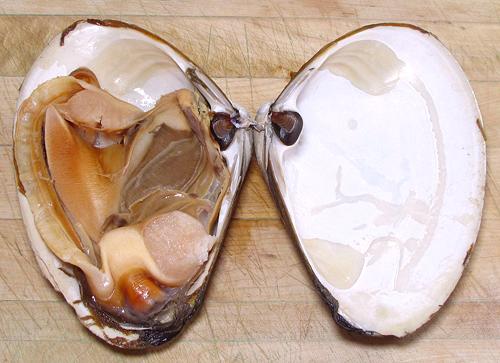Atlantic Surf Clam
 [Hokkigai (Japan); Skimmer, Hen Clam (Maine); Sea Clam, Giant Clam,
Bar Clam (Canada); Spisula solidissima & subspecies]
[Hokkigai (Japan); Skimmer, Hen Clam (Maine); Sea Clam, Giant Clam,
Bar Clam (Canada); Spisula solidissima & subspecies]
This very large clam (often over 6.5 inches) is found in the northwest
Atlantic from the southern Gulf of St. Laurence, Canada, to the Gulf of
Mexico. It is triangular in shape and lives in sand just to the sea side
of the surf zone. In the U.S. the foot (called "tongue") is used
to make clam strips and the strap meat around the edge of the shell and
the adductor muscles that closes the shell are chopped and used for clam
chowder and similar recipes. The foot is also exported to Japan for use
as sushi. It is larger than the foot of their local surf clams.
More on Bivalve Mollusks.
 The edible parts of this clam are the strap meat, top and bottom at
the edge of the shell, including the siphon (at the bottom tip), the
two adductor muscles (opposite the muscle scars on the top shell at the
right), and the foot (center left). The rest is the gill (center right)
under which is a big bag of whatever the clam has sucked in recently,
sort of like a full vacuum cleaner bag.
The edible parts of this clam are the strap meat, top and bottom at
the edge of the shell, including the siphon (at the bottom tip), the
two adductor muscles (opposite the muscle scars on the top shell at the
right), and the foot (center left). The rest is the gill (center right)
under which is a big bag of whatever the clam has sucked in recently,
sort of like a full vacuum cleaner bag.
Buying:
You don't want to buy them in the shell, as
pictured at the top of the page, and I'll tell you why. These were
purchased from a large Asian market in Los Angeles (San Gabriel) for
2017 US $3.99 / pound. The two of them cost me $11 for 2.76 pounds.
This yielded 6.5 ounces of edible clam. That equals $27 / pound edible
- and half of that is just chowder grade.
 This is how the feet are sold, boxed in the frozen food cases of
Asian markets here in Los Angeles. How they get that pretty red
and white color scheme, I don't know. The live ones were beige and
barely reddish towards the tip.
This is how the feet are sold, boxed in the frozen food cases of
Asian markets here in Los Angeles. How they get that pretty red
and white color scheme, I don't know. The live ones were beige and
barely reddish towards the tip.
sf_bvsurfz 170411 - www.clovegarden.com
©Andrew Grygus - agryg@clovegaden.com - Photos on this
page not otherwise credited are © cg1 -
Linking to and non-commercial use of this page permitted
 The edible parts of this clam are the strap meat, top and bottom at
the edge of the shell, including the siphon (at the bottom tip), the
two adductor muscles (opposite the muscle scars on the top shell at the
right), and the foot (center left). The rest is the gill (center right)
under which is a big bag of whatever the clam has sucked in recently,
sort of like a full vacuum cleaner bag.
The edible parts of this clam are the strap meat, top and bottom at
the edge of the shell, including the siphon (at the bottom tip), the
two adductor muscles (opposite the muscle scars on the top shell at the
right), and the foot (center left). The rest is the gill (center right)
under which is a big bag of whatever the clam has sucked in recently,
sort of like a full vacuum cleaner bag. [Hokkigai (Japan); Skimmer, Hen Clam (Maine); Sea Clam, Giant Clam,
Bar Clam (Canada); Spisula solidissima & subspecies]
[Hokkigai (Japan); Skimmer, Hen Clam (Maine); Sea Clam, Giant Clam,
Bar Clam (Canada); Spisula solidissima & subspecies]
 This is how the feet are sold, boxed in the frozen food cases of
Asian markets here in Los Angeles. How they get that pretty red
and white color scheme, I don't know. The live ones were beige and
barely reddish towards the tip.
This is how the feet are sold, boxed in the frozen food cases of
Asian markets here in Los Angeles. How they get that pretty red
and white color scheme, I don't know. The live ones were beige and
barely reddish towards the tip.